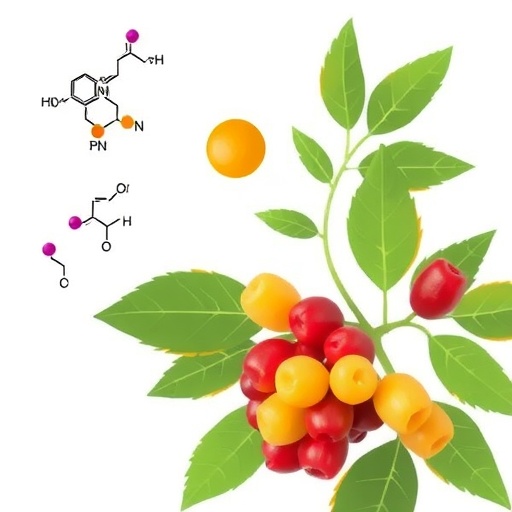A pioneering study has illuminated the remarkable potential of leaf and fruit extracts from the plant species Hypericum revolutum Vahl—commonly known as Amija. Researchers Moges, Manahelohe, and Assege have embarked on a comprehensive phytochemical investigation aimed at unraveling the therapeutic properties of this plant, particularly its antioxidant and antibacterial activities. The study, set to be published in BMC Complementary Medicine and Therapies, offers groundbreaking insights into the untapped capabilities of plant-based remedies in modern medicine.
The scientific community has long been fascinated by the natural world and its myriad of compounds that may contribute to human health. Hypericum revolutum, with its rich historical usage in traditional medicine, serves as a remarkable example. The researchers focused attention on the various chemical constituents present in both the leaf and fruit extracts of this species, aiming to elucidate their bioactivity and potential benefits to human health through meticulous laboratory analysis.
Antioxidants play a crucial role in protecting the body from oxidative stress, which has been implicated in numerous chronic diseases, including cancer and cardiovascular disorders. The study examined the in vitro antioxidant capacities of the extracts obtained from Hypericum revolutum, revealing that these extracts possess a particularly high level of free radical scavenging activity. This indicates that they may protect cellular structures and biomolecules from oxidative damage, thus holding promise for developing novel health supplements or medicinal products.
In conjunction with their antioxidant capabilities, the antibacterial properties of Hypericum revolutum extracts were scrutinized. The researchers conducted a series of assays to assess the effectiveness of these plant extracts against a range of pathogenic bacteria. The results were quite compelling, showcasing potent antimicrobial activity, particularly against strains known for their resistance to conventional antibiotics. This finding underscores the potential role such plant-derived substances might play in combating antibiotic-resistant infections, a growing concern in global health.
Essential oils derived from plants have also garnered significant attention in recent years for their diverse therapeutic properties. The study included an analysis of the essential oil composition gleaned from the leaf extracts of Hypericum revolutum. This meticulous examination not only identified a variety of beneficial compounds but also indicated their concentrations within the oil. Such information is invaluable for formulating effective treatments and understanding how these compounds interact with biological systems.
From a methodological standpoint, the research employed various sophisticated techniques for the extraction and analysis of phytochemicals. This included gas chromatography-mass spectrometry (GC-MS), a powerful tool for characterizing volatile and semi-volatile compounds present in essential oils. The precision of this technology allowed researchers to paint a comprehensive picture of the active constituents, thereby enhancing the reliability of their findings.
The implications of these findings extend far beyond academic interest. With increasing public demand for natural and organic health products, the pharmacological potential of Hypericum revolutum could lead to the development of innovative treatments that are both effective and aligned with holistic health paradigms. The integration of such botanical advancements into therapeutic practices could significantly enhance patient care and broaden the available treatment modalities.
In addition to implications for public health, this research contributes to a growing body of literature advocating for sustainable practices in medicine. By tapping into local flora like Hypericum revolutum, we have the opportunity to promote biodiversity and utilize resources that are often indigenous to specific regions. This approach not only fosters the preservation of traditional knowledge but also encourages economic opportunities in local communities through the development of natural health products.
As the plant-based health movement continues to gain momentum, the contributions made by this investigation are timely and crucial. Education and awareness surrounding products derived from traditional medicinal plants can further empower consumers to make informed choices regarding their health. Such knowledge can lead to greater acceptance and utilization of herbal remedies, effectively bridging the gap between ancient wisdom and modern scientific validation.
While the study is compelling in its own right, it also opens the door for further research. Future investigations could expand upon these findings, exploring additional plant species with known pharmacological properties. Additionally, understanding the mechanisms behind the observed activities of Hypericum revolutum could lead to the discovery of novel therapeutic agents. By delving deeper into the complexities of plant chemistry and biology, researchers can continue to uncover the secrets held within nature.
In conclusion, the pioneering study by Moges and colleagues lays foundational work that highlights the promising antioxidant and antibacterial properties of Hypericum revolutum. As science increasingly moves toward integrative approaches to health, studies such as this provide essential groundwork for understanding how natural products can play pivotal roles in modern therapeutic practices, thus fostering a future where traditional medicine and contemporary healthcare coexist harmoniously.
The excitement generated by this research is palpable, particularly among those invested in the fields of phytochemistry, pharmacognosy, and herbal medicine. The intersections of culture, history, and modern science create a rich tapestry from which new therapeutic avenues can emerge, making the exploration of plants like Hypericum revolutum not just relevant but essential in our pursuit of health and well-being in today’s world.
The journey into the phytochemical landscape of Hypericum revolutum is far from over. As additional studies are likely to follow, we can anticipate enriched discussions around the importance of plant-based therapies in our ongoing battle against disease. Ultimately, the combination of ancient herbal wisdom and cutting-edge scientific inquiry may well redefine our approach to health and healing.
Subject of Research: Phytochemical investigation of Hypericum revolutum Vahl (Amija), focusing on antioxidant and antibacterial activities.
Article Title: Phytochemical investigation, in vitro antioxidant, antibacterial activities of the leaf and fruit extracts of Hypericum revolutum Vahl (Amija), and essential oil composition of the leaf extract.
Article References:
Moges, G.W., Manahelohe, G.M., Assege, M.A. et al. Phytochemical investigation, in vitro antioxidant, antibacterial activities of the leaf and fruit extracts of Hypericum revolutum Vahl (Amija), and essential oil composition of the leaf extract.
BMC Complement Med Ther 25, 395 (2025). https://doi.org/10.1186/s12906-025-05134-z
Image Credits: AI Generated
DOI: 10.1186/s12906-025-05134-z
Keywords: Phytochemistry, Hypericum revolutum, antioxidant activity, antibacterial activity, essential oil.




